COVID-19 mRNA in Boston Wastewater
Tagged:COVID
/
JournalClub
/
MathInTheNews
/
Politics
Some good news: Boston COVID-19 wastewater levels were at (and now slightly above) the 2-year low.
Wastewater Tracking
Measuring levels of SARS-CoV2 mRNA levels in sewage have a number of attractive properties. It’s almost impossible to cheat: everybody uses a toiler sooner or later, whereas nowadays almost nobody reports a positive test taken at home. It’s better even than hospital admissions: even though the hospital testing for COVID-19 is objective, the patients admitted now are only the most very severe, as compared to the beginning of the pandemic.
So it’s got the desirable property of measuring reality, rather than reality plus people’s preferences about reporting.
That’s why we’ve written about it a number of times, here on this Crummy Little Blog That Nobody Reads (CLBTNR). [1] [2] [3] [4]
We had hoped to find a time-lagged relationship between wastewater mRNA levels and various
sorts of medical loads, like hospital admissions, death rates, and so on. Reality, of
course had other ideas: each wave was more or less sui generis:
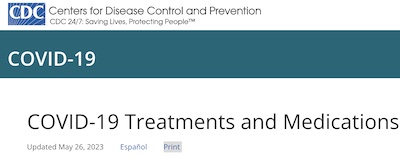
- The medical standard of care changed as we learned about SARS-CoV2 and how it manifests
as COVID-19 (breakthrough infections in the vaccinated, prone ventilation,
dexamethasone, remdesivir, paxlovid, convalescent plasma
…). The CDC has a nice report on the drugs currently available, which were
either developed over time or discovered to be something we could re-purpose for
COVID-19. [5]
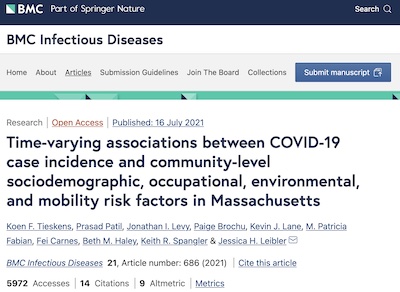
- The population at risk changed (becoming more vaccinated or more immune through previous infection, also many elderly/medically frail people having been killed). A paper published a couple years ago in BMC Infectious Diseases documented this exact population shift in Massachusetts [6], the same population we’re considering today.
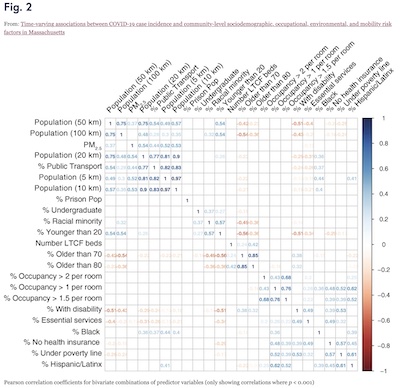 The Tieskens paper is quite interesting. They examined many risk factors and found
about 22 that were related to COVID-19, and measured their correlations to find block structures.
This is shown in their Figure 2:
The Tieskens paper is quite interesting. They examined many risk factors and found
about 22 that were related to COVID-19, and measured their correlations to find block structures.
This is shown in their Figure 2:
- There is a block of correlated variables in the upper left which appears to be population density, measured various ways. This does not mean urban living is more dangerous! Quite the contrary, since it usually indicates proximity to big hospitals. Rather, there are just more people there, and hence more cases. So we conclude that any predictor model had better correct for population density (which they did, q.v.). (Also, their Figure 1 showed the same population effect by looking at Massachusetts county by county, seeing COVID-19 cases over time.)
- Another block in the lower right appears to be more or less crowded housing, being poor, Black, Hispanic, or lacking health insurance. All of those are scary during the best of times, but more deadly during the pandemic.
- There’s another block in the middle which seems to have to do with being elderly or being in a long-term care facility.
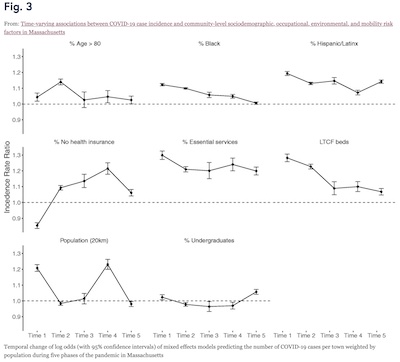 They put these into a
backward predictor selection process
finding 8 fixed-effect predictor variables that all had some goodness of fit during the 5
phases of the pandemic then observable. Their predictor was a
mixed-effect, adjusted Poisson regression.
(Recall: Poisson models predict discrete counts in the limit of large case numbers, as
appropriate here.)
They put these into a
backward predictor selection process
finding 8 fixed-effect predictor variables that all had some goodness of fit during the 5
phases of the pandemic then observable. Their predictor was a
mixed-effect, adjusted Poisson regression.
(Recall: Poisson models predict discrete counts in the limit of large case numbers, as
appropriate here.)
These variables gave coverage of each of the correlated predictor blocks seen in the correlation matrix above. They measured the influence of each of the 8 variables by looking at the log odds (and 95% CL) of mixed effects models predicting COVID-19, population-weighted for each town (Figure 3; large positive values mean it’s a risk factor; negative values mean it’s a protective factor):
- Some of them look pretty constant, like availability of essential services and being an undergraduate. Regrettably, the risks for Hispanics remained high.
- Others show trends, like being Black or in a long-term care facility (both, gratefully, decreasing as we tried to enforce some kind of equity among minorities and the elderly).
- Others showed peaks, like age over 80, not having health insurance, and population density. Something about the middle of the pandemic made those even riskier than they usually were.
Conclusion: Not all pandemic waves are the same! Not medically, and not demographically.
What’s the State of Boston’s COVID-19 mRNA Levels Now?
While we can’t predict medical loads very well from fits against data in previous waves, we can nonetheless measure how much COVID-19 is running around in the population, regardless of the level of test reports.
So were are we now?
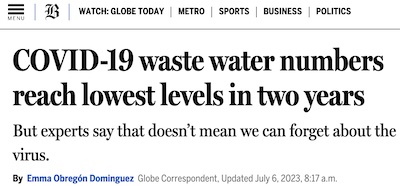 An article today in the venerable Globe [7] points out that
the SARS-CoV2 mRNA levels detected in Boston wastewater are now quite low, as in the
lowest in 2 years.
An article today in the venerable Globe [7] points out that
the SARS-CoV2 mRNA levels detected in Boston wastewater are now quite low, as in the
lowest in 2 years.
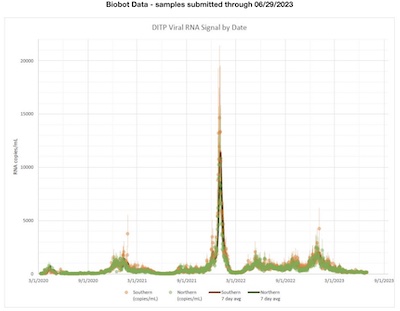 Reliable as the Globe occasionally is, we decided to check the primary source for the
data. That would be the Massachusetts Water Resource Authority (MWRA), and the tracking
data they collect from the Deer Island treatment plant. [8]
Reliable as the Globe occasionally is, we decided to check the primary source for the
data. That would be the Massachusetts Water Resource Authority (MWRA), and the tracking
data they collect from the Deer Island treatment plant. [8]
As you can see, the current levels are indeed low, compared to previous waves. However, the extreme peak of the Omicron wave at the beginning of 2022 dwarfs everything else. While I wish they would show it on a vertical log scale, I’m not going to replot their data.
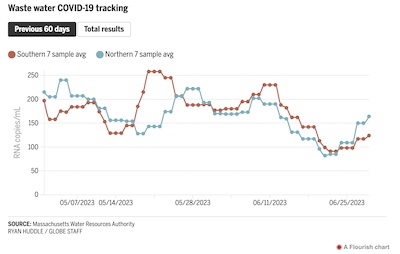 You can see a zoomed-in picture on recent data either on the MWRA site (separated by North
and South water districts), or you can consider the Globe’s zoomed in version,
shown here:
You can see a zoomed-in picture on recent data either on the MWRA site (separated by North
and South water districts), or you can consider the Globe’s zoomed in version,
shown here:
- The absolute minimum was a couple weeks ago, around 2023-June-23, at a bit below 100 copies/mL.
- While it’s risen a bit since then, the change is clearly not terribly meaningful: about 50 copies/mL increase, when previous waves had 1000 copies/mL to around 10,000 copies/mL. This is very likely noise, though we haven’t done formal statistical testing to establish that.
We have a highly vaccinated population in Boston, and it shows here. But, in the fall when students return from all over the world, we should probably see an uptick. (When teaching at MIT, many years ago as a grad student, I’d always get a bad cold in September or October, as I was exposed to students upon their return. A cold, I’m happy to tolerate in exchange for the opportunity to teach them. I’m less sanguine about COVID-19!)
The Weekend Conclusion
COVID-19 is not over, no matter what your friends tell you. Here at Château Weekend we note with sadness that some less cautious friends of ours have recently caught COVID-19 for the fourth time, despite being fully vaccinated. Risk exposure is not without its consequences.
The political “end” of the public health emergency means we’ve been blinded to the data. But it appears about 1000 people are dying each week in the US. We act like 50,000 dead every year is no big deal. 50,000 people… somehow “no big deal”.
It is incredibly stupid & cruel to normalize this sort of death rate!
If you’re eligible for a second dose of the bivalent booster (over 65, other medical need), then you should definitely get it now.
The US FDA’s VRBPAC (Vaccine and Related Biological Product Advisory Committee) voted on 2023-Jun-15 to authorize a fall booster this year tuned to the latest variant, XBB.1.5. [9]
Yes, of course you should get this fall booster. Don’t ask silly questions, or at least ask them after getting the fall booster. Just get the fall booster.
Live, and not die.
Notes & References
1: Weekend Editor, “Wastewater coronavirus RNA vs medical loads”, Some Weekend Reading blog, 2020-Nov-04. ↩
2: Weekend Editor, “Wastewater Revisited: Metagenomic Viral RNA and Medical Loads”, Some Weekend Reading blog, 2021-May-21. ↩
3: Weekend Editor, “Boston Wastewater Re-Re-Visited: Sewage Viral RNA vs COVID-19 Cases and Deaths”, Some Weekend Reading blog, 2022-Feb-04. ↩
4: Weekend Editor, “SARS-CoV2 Cryptic Sequences in NYC Wastewater: Why Not to Sleep Well at Night”, Some Weekend Reading blog, 2022-Feb-07. ↩
5: CDC Staff, “COVID-19 Treatments and Medications”, US Centers for Disease Control and Prevention, updated 2023-May-26, retrieved 2023-Jul-06. ↩
6: KF Tieskens, et al., “Time-varying associations between COVID-19 case incidence and community-level sociodemographic, occupational, environmental, and mobility risk factors in Massachusetts”, BMC Infect Dis, 21:686, 2021-Jul-16. ↩
7: Emma Obregón Dominguez, “COVID-19 waste water numbers reach lowest levels in two years”, Boston Globe, 2023-Jul-06. ↩
8: MWRA Staff, Biobot wastewater RNA data, Massachusetts Water Resource Authority, data through 2023-Jun-29 retrieved 2023-Jul-06. ↩
9: US FDA Staff, “Updated COVID-19 Vaccines for Use in the United States Beginning in Fall 2023”, US Food & Drug Administration press releases, 2023-Jun-15. ↩

Gestae Commentaria
Comments for this post are closed pending repair of the comment system, but the Email/Twitter/Mastodon icons at page-top always work.